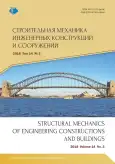PROBLEM OF NUMERICAL ANALYSIS OF DEFORMATION OF BINDED REINFORCED CONCRETE ELEMENTS
- Authors: Markovich AS1, Abu Makhadi M.I.1, Miloserdova DA1, Akifeva KS1, Asad MA.1
-
Affiliations:
- Peoples’ Friendship University of Russia (RUDN University)
- Issue: Vol 14, No 3 (2018)
- Pages: 233-241
- Section: Numerical methods of structures’ analysis
- URL: https://journal-vniispk.ru/1815-5235/article/view/346321
- DOI: https://doi.org/10.22363/1815-5235-2018-14-3-233-241
- ID: 346321
Cite item
Full Text
Abstract
In 1938 standards were adopted in which the method of limiting equilibrium, developed by prof. А.А. Gvozdev and V.I. Murashev, was recommended for the calculation of reinforced concrete structures. From the very beginning, the proposed method caused a sharp discussion in the scientific community, since it contained number of contradictions. Most of the contradictions in the theory of A.A. Gvozdev became part of modern Russian standards. Until now the method of limiting equilibrium remains the main method for calculating reinforced concrete structures for strength. In recent years, a discussion has been developed on the transition to the deformation model of reinforced concrete resistance used by the European codes. In view of this, the updated version of domestic regulations allows the calculation of reinforced concrete structures using a nonlinear deformation model. However, there is a limited number of studies confirming the consistency of the proposed deformation model. In this regard we performed a series of calculations of rigidity of hinged supported on the basis of the theoretical and deformation models of the Russian standards. The calculation was carried out by the finite element method using the model of nonlinear deformation of concrete.
About the authors
A S Markovich
Peoples’ Friendship University of Russia (RUDN University)
Author for correspondence.
Email: markovich.rudn@gmail.com
PhD in Technical Sciences, Associate Professor of the Department of Architecture and Civil Engineering, Engineering Academy, Peoples' Friendship University of Russia (RUDN University). Scientific interests: structural mechanics, numerical methods for calculating structures, computer modeling
6 Miklukho-Maklaya St., Moscow, 117198, RussiaMokhammed Ibragim Abu Makhadi
Peoples’ Friendship University of Russia (RUDN University)
Email: moham_d@mail.ru
PhD in Technical Sciences, Associate Professor of the Department of Architecture and Civil Engineering, Engineering Academy, Peoples' Friendship University of Russia (RUDN University). Scientific interests: soil mechanics, foundations, building materials, numerical methods for calculating structures
6 Miklukho-Maklaya St., Moscow, 117198, RussiaD A Miloserdova
Peoples’ Friendship University of Russia (RUDN University)
Email: milos-dasha@yandex.ru
Master’s Degree Student of the Department of Architecture and Civil Engineering, Engineering Academy, Peoples' Friendship University of Russia (RUDN University). Scientific interests: calculation and design of buildings and structures
6 Miklukho-Maklaya St., Moscow, 117198, RussiaK S Akifeva
Peoples’ Friendship University of Russia (RUDN University)
Email: kristina_akifeva_svna@mail.ru
Master’s Degree Student of the Department of Architecture and Civil Engineering, Engineering Academy, Peoples' Friendship University of Russia (RUDN University). Scientific interests: calculation and design of buildings and structures
6 Miklukho-Maklaya St., Moscow, 117198, RussiaM Ali Asad
Peoples’ Friendship University of Russia (RUDN University)
Email: moh_664@yahoo.com
Master’s Degree Student of the Department of Architecture and Civil Engineering, Engineering Academy, Peoples' Friendship University of Russia (RUDN University). Scientific interests: calculation and design of buildings and structures
6 Miklukho-Maklaya St., Moscow, 117198, RussiaReferences
- Murashev V.I. (1938). Raschet zhelezobetonnykh elementov po stadii razrusheniya [Calculation of reinforced concrete elements by the stage of destruction]. Moscow – Leningrad: Gosstroiizdat, 184. (In Russ.)
- Code of Practice 52-103-2007 (2007). Concrete monolithic building structures. The Research Center of Construction, Moscow. (In Russ.)
- Code of Practice 63.13330.2012. (2013). Concrete and reinforced concrete structures. Design requirements. The Research Center of Construction, Moscow. (In Russ.)
- Code of Practice 52-101-2003. (2005). Manual for the design of concrete and reinforced concrete structures from heavy concrete without prestressing of reinforcement. The Research Center of Construction, Moscow. (In Russ.)
- Sanzarovskij R.S. (2012). Mistakes of the standards for the design of reinforced concrete. Structural Mechanics of Engineering Constructions and Buildings, (3), 57–65. (In Russ.)
- Sanzarovskij R.S., Musabaev T.T. (2014). About non-compliance the Eurocode and the standard for the design of concrete and reinforced concrete structures. Concrete and reinforced concrete – looking into the future. Scientific works of III All-Russian (II International) Conference on concrete and reinforced concrete, in 7 volumes, 6, 448–458. (In Russ.)
- Zvezdov A.I., Sanzharovskij R.S., Rybnov E.I. (2012). On national standards for reinforced concrete and ways to improve them. Concrete and reinforced concrete, (2), 19–20. (In Russ.)
- Sanzharovskij R.S., Manchenko M.M. (2017). Errors of international standards on reinforced concrete and rules of the Eurocode. Structural Mechanics and Analysis of Constructions, (6), 25–36. (In Russ.)
- Zalesov A.S., Pashchanin A.A. (2011). Calculation of the strength of reinforced concrete beams with the use of volumetric finite elements in the development of standards for the design of reinforced concrete structures. Construction mechanics and calculation of structures, (4), 66–71. (In Russ.)
- Starchous I.V., Burtsev V.M. (2016). Calculation of flexible reinforced concrete elements by strength of normal sections with the use of a deformation model. Russian Far East: problems of development of the architectural and construction complex, (1), 449–452. (In Russ.)
- Benin A.V., Semenov A.S., Semenov S.G., Fedorov I.V. (2011). Finite element modeling of the processes of inelastic deformation and fracture of elements of reinforced concrete structures. Marine intelligent technologies, 3(13), 102–105. (In Russ.)
- Agapov V.P. (2004). Finite Element Method in Static, Dynamics and Stability of Structures. Textbook. 2nd Edition. Publishing House of Educational Civil Engineering Institutions, Moscow. (In Russ.)
- Agapov V.P., Bardysheva Y.A., Minakov S.A. (2010). Accounting for physical and geometric nonlinearity in the calculation of reinforced concrete slabs and shells of variable thickness by the finite element method. Structural Mechanics and Analysis of Constructions, (5), 62–66. (In Russ.)
- Agapov V.P. (2007). Nonlinear static and buckling analysis of thin plates and shells by finite element method. International Journal for Computational Civil and Structural Engineering, 3(2), 13–19.
- Gorodetskij D.A., Barabash M.S., Vodopyanov R.Y., Titok V.P., Artamonova A.E. (2013). The program complex LIRA-SAPR 2013. Textbook. Edited by A.S. Gorodetskij. Electronic edition, Moscow. (In Russ.)
Supplementary files









